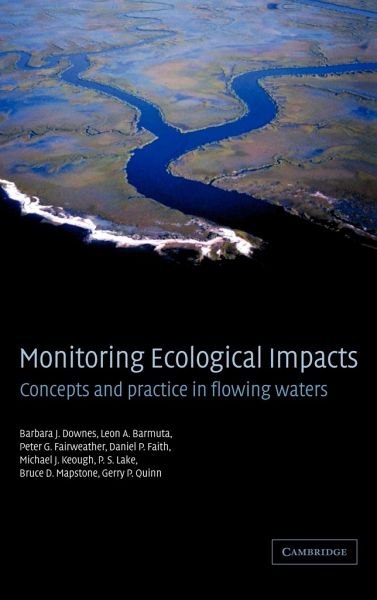
Monitoring Ecological Impacts
Concepts and Practice in Flowing Waters
Versandkostenfrei!
Versandfertig in 1-2 Wochen
145,99 €
inkl. MwSt.
Weitere Ausgaben:

PAYBACK Punkte
73 °P sammeln!
Monitoring Ecological Impacts provides the tools needed by professional ecologists, scientists, engineers, planners and managers to design assessment programs that can reliably monitor, detect and allow management of human impacts on the natural environment. The procedures described are well-grounded in inferential logic, and the statistical models needed to analyse complex data are given. Step-by-step guidelines and flow diagrams provide the reader with clear and useable protocols, which can be applied in any region of the world and to a wide range of human impacts. In addition, real examples...
Monitoring Ecological Impacts provides the tools needed by professional ecologists, scientists, engineers, planners and managers to design assessment programs that can reliably monitor, detect and allow management of human impacts on the natural environment. The procedures described are well-grounded in inferential logic, and the statistical models needed to analyse complex data are given. Step-by-step guidelines and flow diagrams provide the reader with clear and useable protocols, which can be applied in any region of the world and to a wide range of human impacts. In addition, real examples are used to show how the theory can be put into practice. Although the context of this book is flowing water environments, especially rivers and streams, the advice for designing assessment programs can be applied to any ecosystem.
Table of contents:
Part I. Introduction to the Nature of Monitoring Problems and to Rivers: 1. Why we need well-designed monitoring programs; 2. The ecological nature of flowing waters; 3. Assessment of perturbation; Part II. Principles of Inference and Design: 4. Inferential issues for monitoring; 5. The logical bases of monitoring design; 6. Problems in applying designs; 7. Alternative models for impact assessment; Part III. Applying Principles of Inference and Design: 8. Applying monitoring designs to flowing waters; 9. Inferential uncertainty and multiple lines of evidence; 10. Variables that are used for monitoring in flowing waters; 11. Defining important changes; 12. Decisions and trade-offs; 13. Optimization; 14. The special case of monitoring attempts at restoration; 15. What's next?
Monitoring Ecological Impacts provides the tools needed to design assessment programs that can reliably monitor, detect and allow management of human impacts on the natural environment. The procedures described are well-grounded in inferential logic. Step-by-step guidelines and flow diagrams provide clear and useable protocols, which are applicable to real situations.
Provides clear and useable protocols for the detection and measurement of human impacts on the environment.
Table of contents:
Part I. Introduction to the Nature of Monitoring Problems and to Rivers: 1. Why we need well-designed monitoring programs; 2. The ecological nature of flowing waters; 3. Assessment of perturbation; Part II. Principles of Inference and Design: 4. Inferential issues for monitoring; 5. The logical bases of monitoring design; 6. Problems in applying designs; 7. Alternative models for impact assessment; Part III. Applying Principles of Inference and Design: 8. Applying monitoring designs to flowing waters; 9. Inferential uncertainty and multiple lines of evidence; 10. Variables that are used for monitoring in flowing waters; 11. Defining important changes; 12. Decisions and trade-offs; 13. Optimization; 14. The special case of monitoring attempts at restoration; 15. What's next?
Monitoring Ecological Impacts provides the tools needed to design assessment programs that can reliably monitor, detect and allow management of human impacts on the natural environment. The procedures described are well-grounded in inferential logic. Step-by-step guidelines and flow diagrams provide clear and useable protocols, which are applicable to real situations.
Provides clear and useable protocols for the detection and measurement of human impacts on the environment.














